
If you want to create a Montessori home set up for your child, you’ve come to the right place!
In homes around the world, parents create beautiful prepared environments to help their kids explore the world and build independence. If you’re interested in the belief system behind the Montessori philosophy, read my post here on the Montessori basics.
You don’t have to buy a bunch of wooden toys or stage your home like IKEA to bring the best of Montessori to your home.
As a Montessori school principal (and mom!) I share with you how we do Montessori at home, finding places to make work and play orderly and meaningful.
“Education is not acquired by listening to words, but in virtue of experiences in which the child acts on his environment.”
-Maria Montessori
What is a Montessori work?
In Montessori language, a “work” is a noun to describe a collection of items that go together to make an activity. Children in the Montessori environment spend their day working, so the activities they are working on are called "works." This terminology lends a respect to the effort and purpose of childhood play and engagement.
In the Montessori environment, children take a work off the shelf and bring it to their workspace. They then work with those materials at their pace, following their interests. When they’re done with the work, they reset the tray so it’s ready for the next child and return it to the shelf.
The environment is "prepared" for the children, meaning that it's thoughtfully curated for them and each tray or basket is ready to be taken off the shelf and worked with.
You can bring this wonderful concept home and implement it in your house with a Montessori home set up that uses a rotating series of works. To find out how, read on!
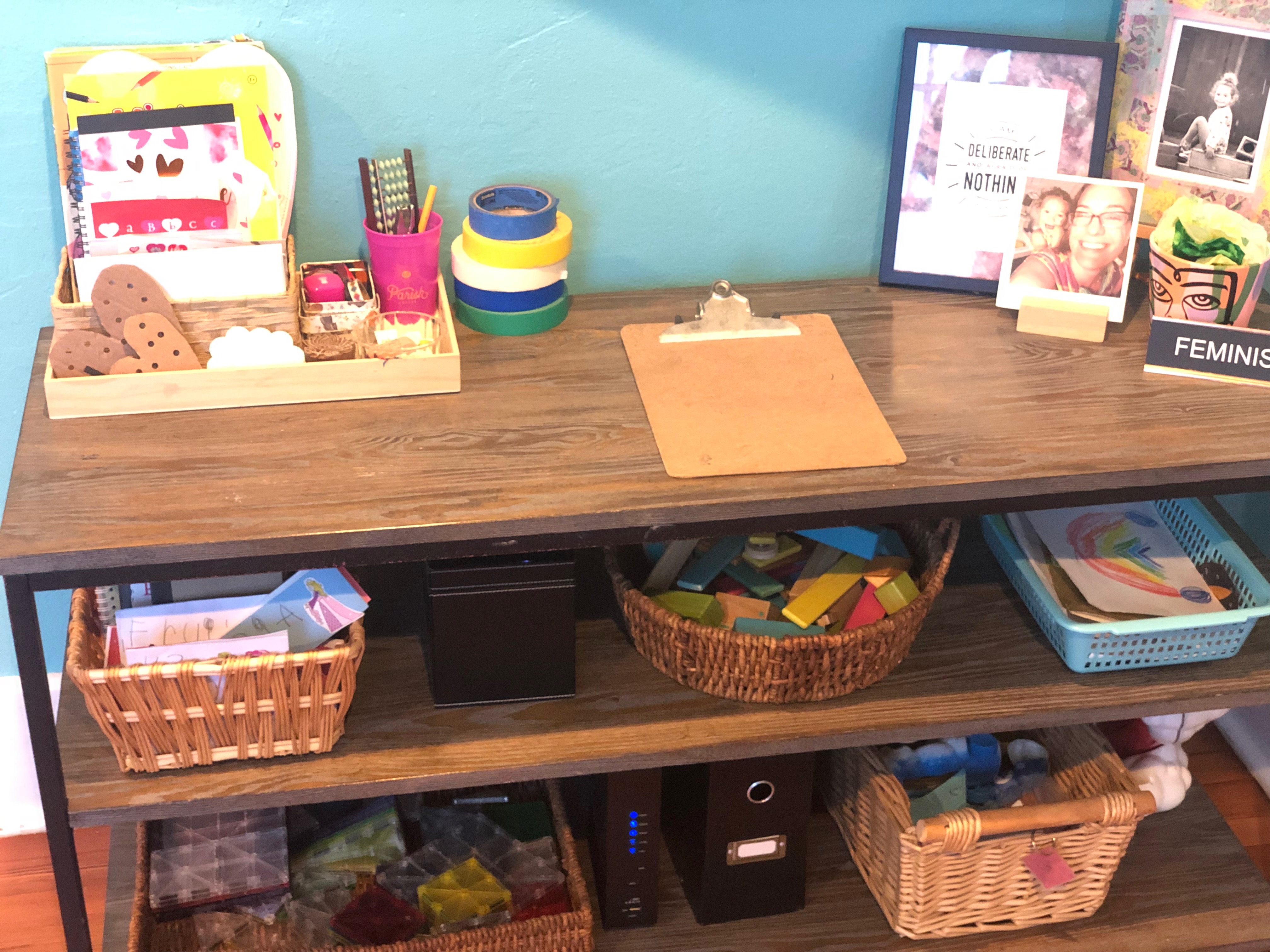
This is the shelf under the television. The top part is her "office," with stickers, paper, pencils, and her tape collection. Below are the building works, a tray where her finished office work goes, and the Care Bears.
Montessori Home Set Up for Works
Start by making the learning and playing environment as orderly as possible in your home. This means putting a limit on the number of items on a shelf and putting visual space around each item so the child can see that it’s separate from other items.
What most of us have at home is a pile of toys in a closet or in a child's room: puzzle pieces separated from their counterparts, three cars under the bed and the rest strewn around the room, the racetrack that goes with the cars somewhere else entirely.
When kids play in a room like this, the toys have less meaning because they are not fully prepared and ready to be played with. That toy they begged you for now is meaningless because of missing pieces or because the effort to get all the pieces together makes the play less fun.
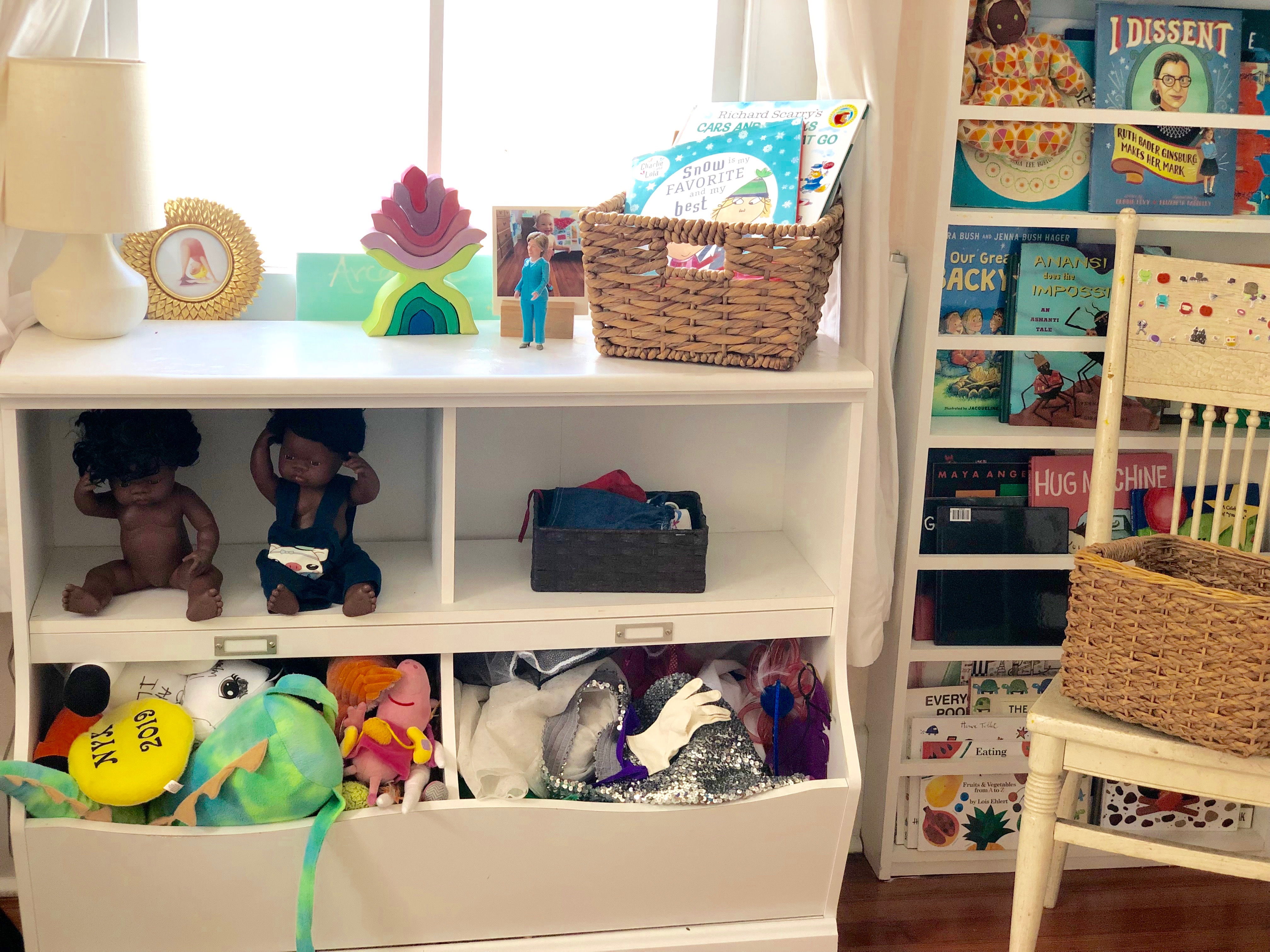
Here, stuffed animals-L, and costumes- R, are stuffed into bins, but the doll clothes that fit these beloved dolls are close at hand.
For example, the fun part, and the important skill involved with making a race track for cars is the creation of the track. Children labor over creating more and more outrageous heights for the cars to run on. This is purposeful play that involves fine motor skills, testing hypotheses, and basic understanding of physics. If they aren't able to find all the pieces, the pay loses its meaning.
So prepare the environment to make playing and working in it even more purposeful. Start by sorting like items into baskets so all the Magnatiles are together, all the dinosaurs are in a basket, and the doll clothes are stored next to the dolls the clothes are meant for.
Find Places for Works
The Montessori home set up that I find the easiest to implement is to decide on three or four areas you would expect your child to be playing in on a regular basis. For us, that’s the living room and her playroom.
One of the major Montessori principles is that children’s things belong throughout the house so they can really identify the space as their own, so make your peace with having “play stuff” in your living room if you can. I find a coffee table full of Montessori works makes a great conversation starter with guests.
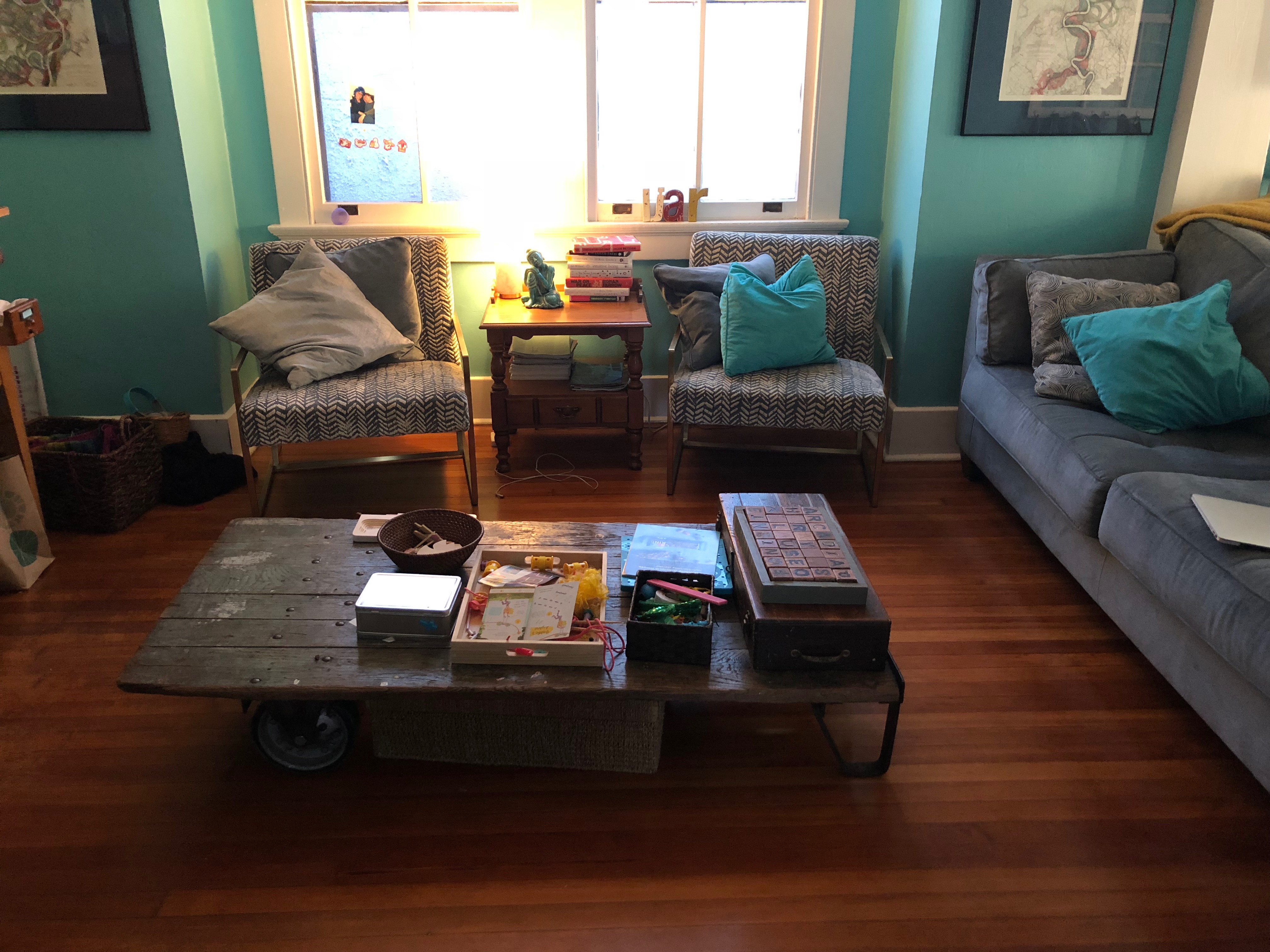
The living room coffee table with activities ready to work with.
In multiple places in your home, find a shelf or cabinet that make a good spot for a series of trays and baskets to live.
In our house, we have four or five works on the coffee table in the living room and another six works (plus her office) on shelves in the same room.
In the playroom, a six-cubby shelving system holds a work in each cube, and another cabinet holds toys and works.
In the top right cube you can see my daughter's "altar," where she places precious things like rocks and pictures and shells. This cube gets messy, but it's her design and I don't usually touch it. Everything else is prepared by me and the items inside are rotated frequently.
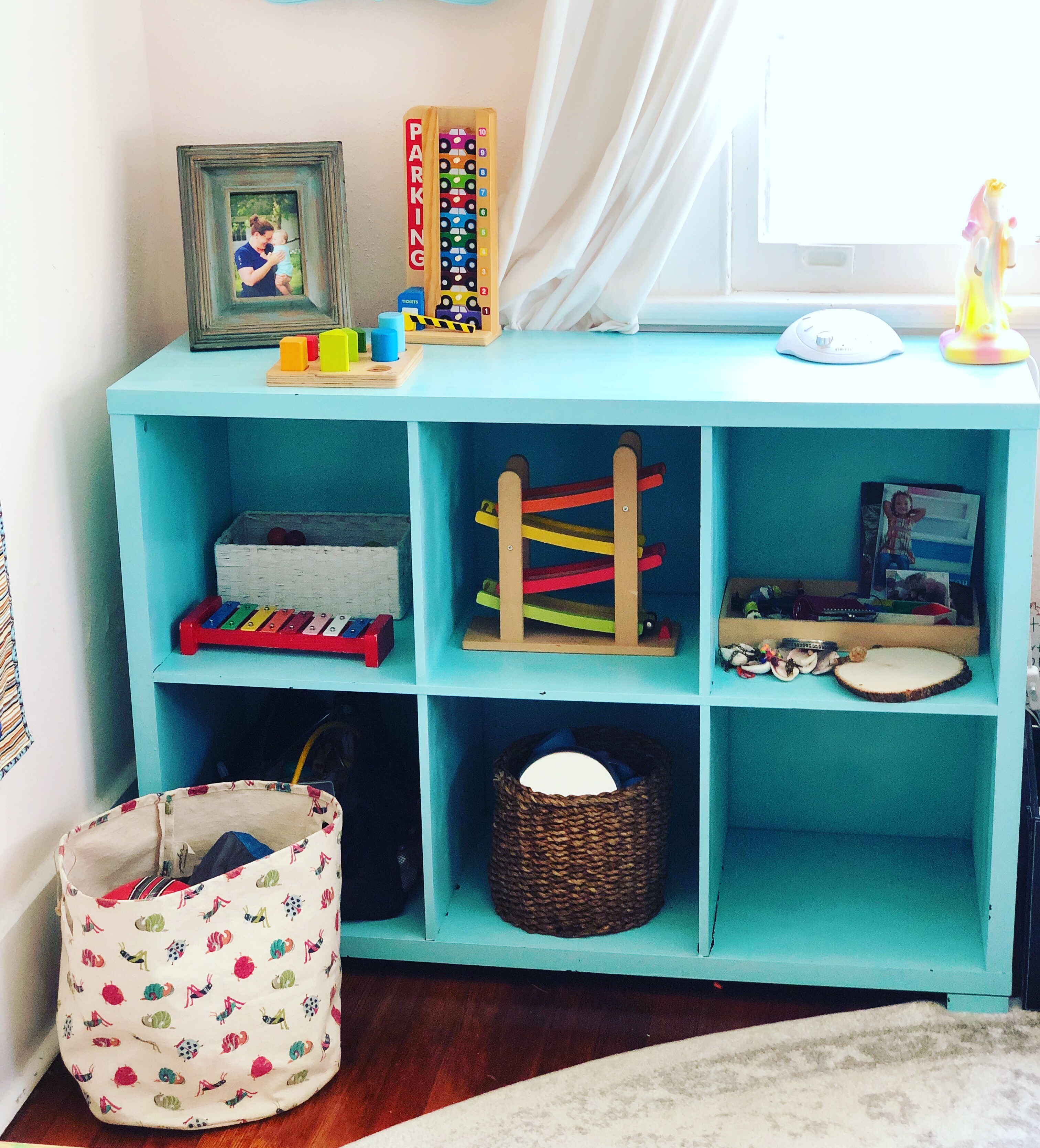
In her room, one of two cube shelves that hold an individual "work" in each cube. From L to R: musical instruments, gravity car toy, altar, doctor bag, tea set, empty shelf because the puzzle was being worked on.
In each space, you can see that I’ve placed a bunch of like items in baskets. That is the core idea of Montessori works-- that each work is self-contained and has items that can be used for a purpose together.
If you’re gonna do this right, you’re gonna need a lot of baskets.
There are two other places that have works/toys.
In the entry way, there is a big basket of seasonal items, and we are still enjoying Mardi Gras throws right now.
When we finish a holiday or a season and I'm putting away the items, she can keep just as many things as fit in that basket. It's our way of saying goodbye to the holiday and still keeping a part of it present every day, until we're ready to put it all away.
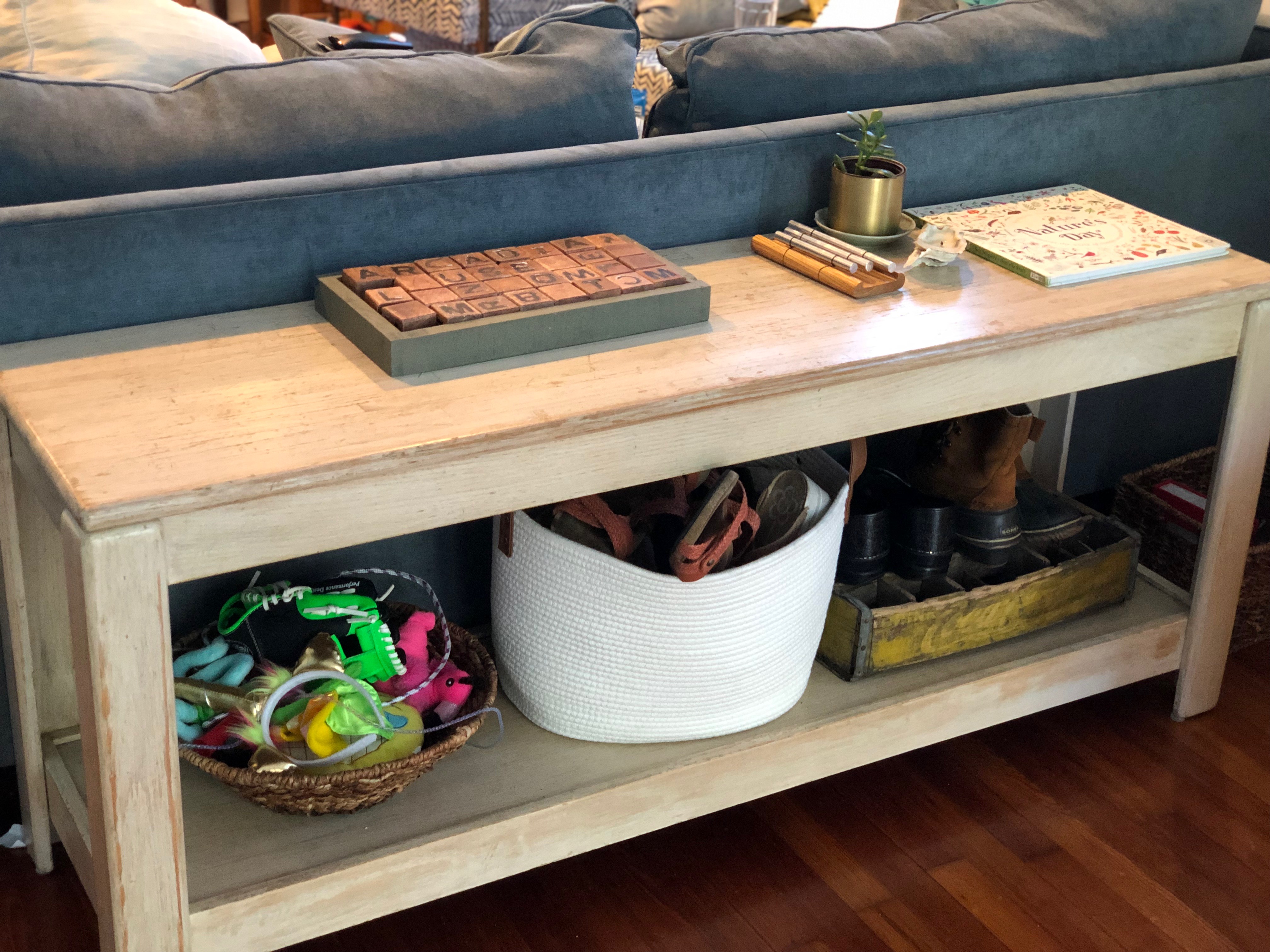
Shoes and her Mardi Gras seasonal basket. On top of the shelf is our three tone chime, candle, and (because it's spring) our nature book.
And in the kitchen at her table she has a nature basket and usually one puzzle.
We also have our art room, which is basically where the kitchen table is (if we used it as a kitchen table). That has her crayons and paints for her to use when she wants and a closet full of art supplies that I get out when I’m ready for them.
And downstairs in the workshop near my Peloton bike is her table with Legos. Read all about how I use Legos to get myself a workout here!
Place like items and activity materials in baskets or on trays, and spread them out so there’s room around each basket.
Encourage your child not to mix materials, and to put materials in works back on the shelf when she is done. Some families use a Montessori mat for kids to roll out and work on. I don’t use one at home like we do at school because I find it a little too structured for our taste.
At home I don’t worry too much about whether she’s getting a balance of works for all subjects or anything like that. I do try to have a few building works, a few writing works, a few puzzles, a few animal-toy-type works, a pretend play work, and the old standbys-- her nature basket, seasonal basket, and costume collection are always out.
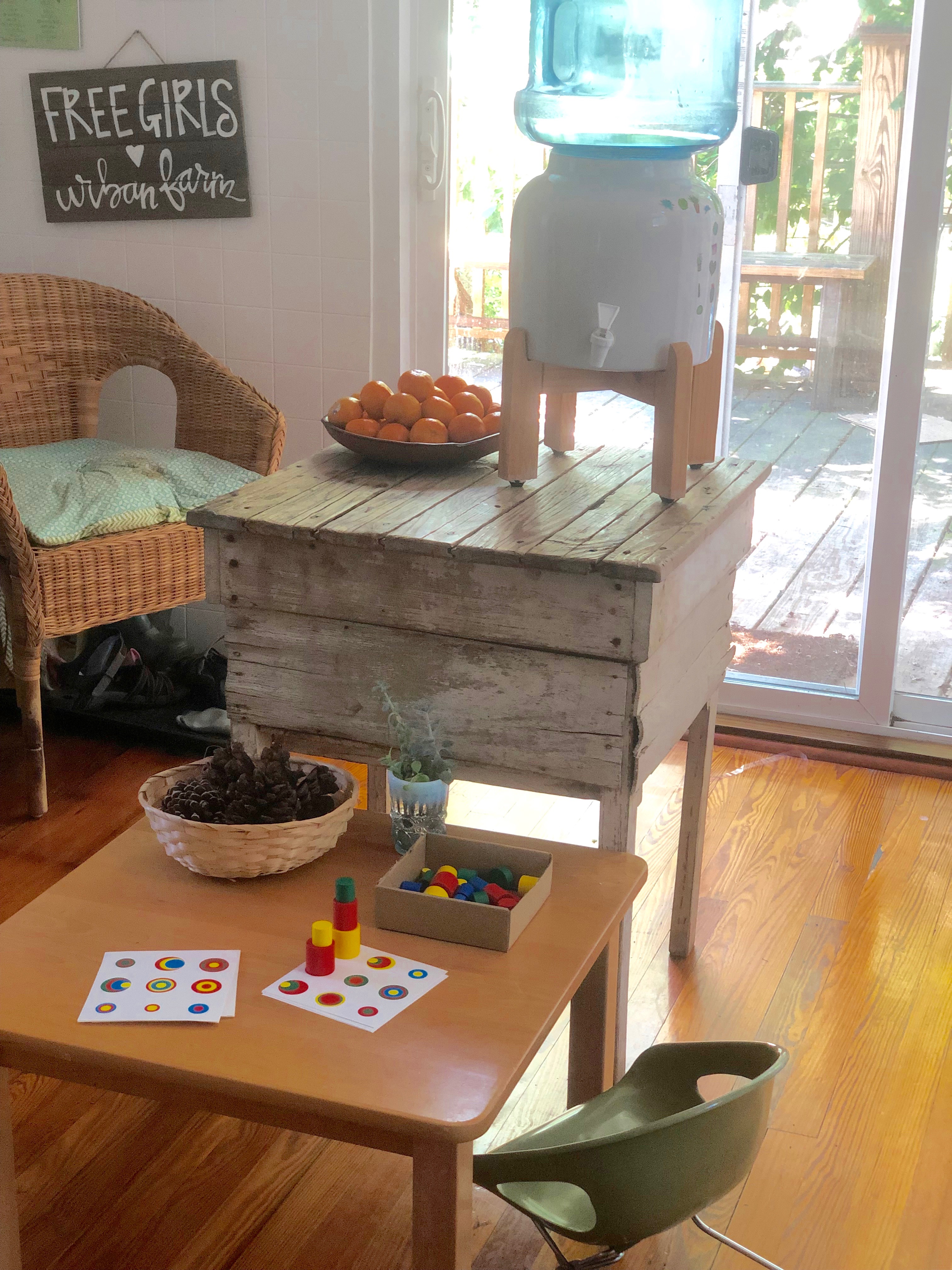
Her table set up in the kitchen with nature basket and a puzzle.
Each Work Has a Purpose
You COULD just put a bunch of dinosaurs in a basket and call it a day. That’s what I have done with a lot of her works over the years. The Care Bears have been a consistent, solid, reliable work from day one. It’s just a bunch of bears in a basket (or in a plastic bag if we’re on a camping trip.) But what makes that such a great work is everything you can DO with the bears.
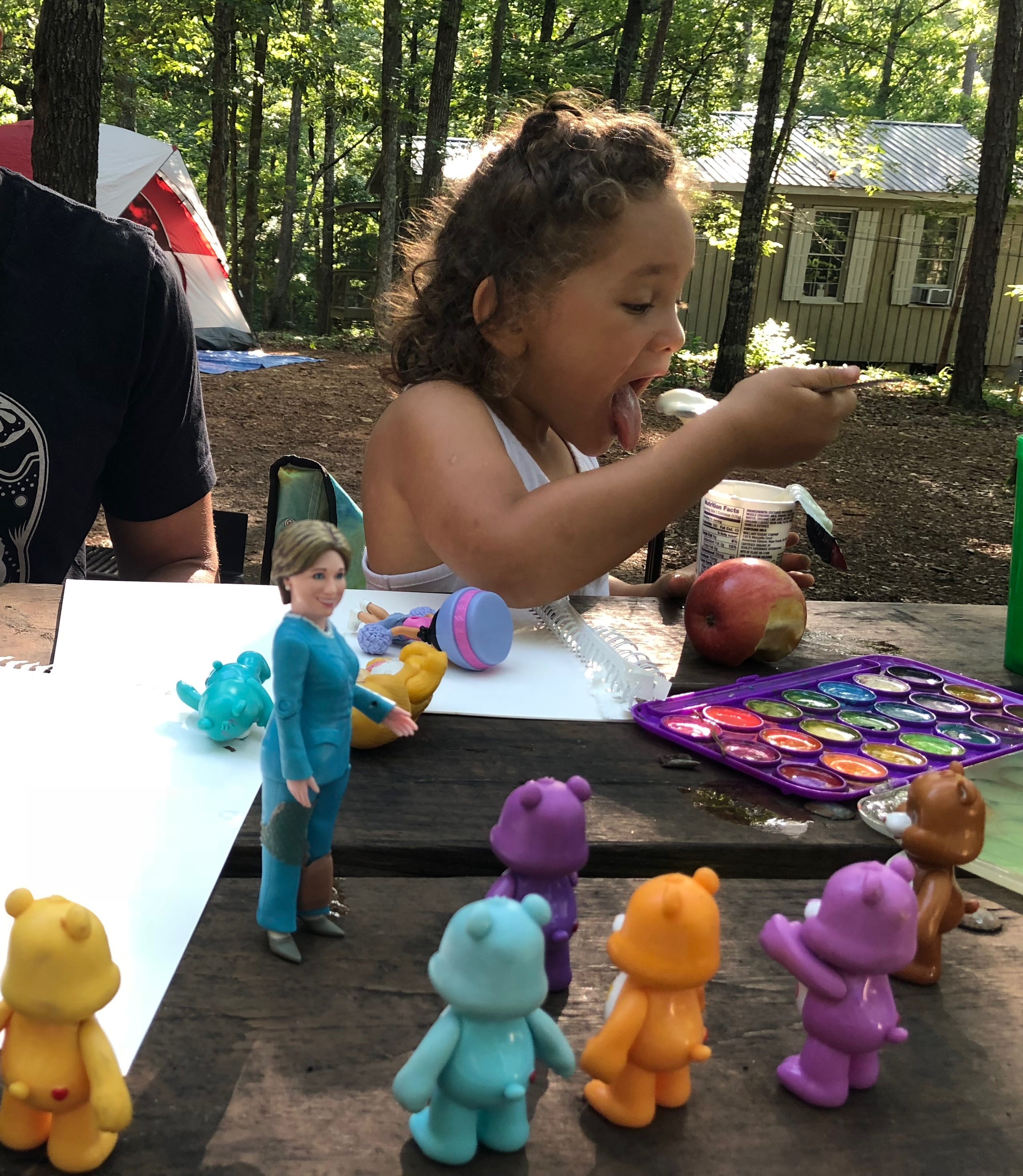
When we're camping, we put several works in plastic bags and haul them out just like we would at home. Here, the Care Bears line up at breakfast..
You can line them up (work on fine motor skills and balance). You could put them in rainbow order (work on color progression).
You could pair them up by tummy design (work on synthesizing ideas). You could give them baths and see if they float, you could draw the tummy badges, you could try to balance as many of them as possible on top of one another... you get my drift.
For each work, there should be a clear purpose. You don’t have to explain that purpose to your child, but you should know the point of the work. Sometimes it’s really easy: a puzzle is for developing spatial awareness and problem solving skills. Other times you build a work by following your child’s mind, seeing how they play, and creating an activity that will interest them and build their skills.
My daughter loves picking up leaves at the coffee shop where we hang out on Sunday mornings. One day, a work appeared on the coffee table with all the leaves she’d collected, a few pieces of small paper, and a pencil.
She traced those leaves over and over again, and that work was really popular in our house for about two weeks.
After tracing, she would write on the leaf--sometimes a description of the leaf (sometimes just her name). Then, when she had traced ten or twenty, she wanted to make them into a book.
The next day, construction paper, a scissors, and a stapler appeared on the work tray. Not only was the purpose clear, she had everything on the tray she needed to make the book.
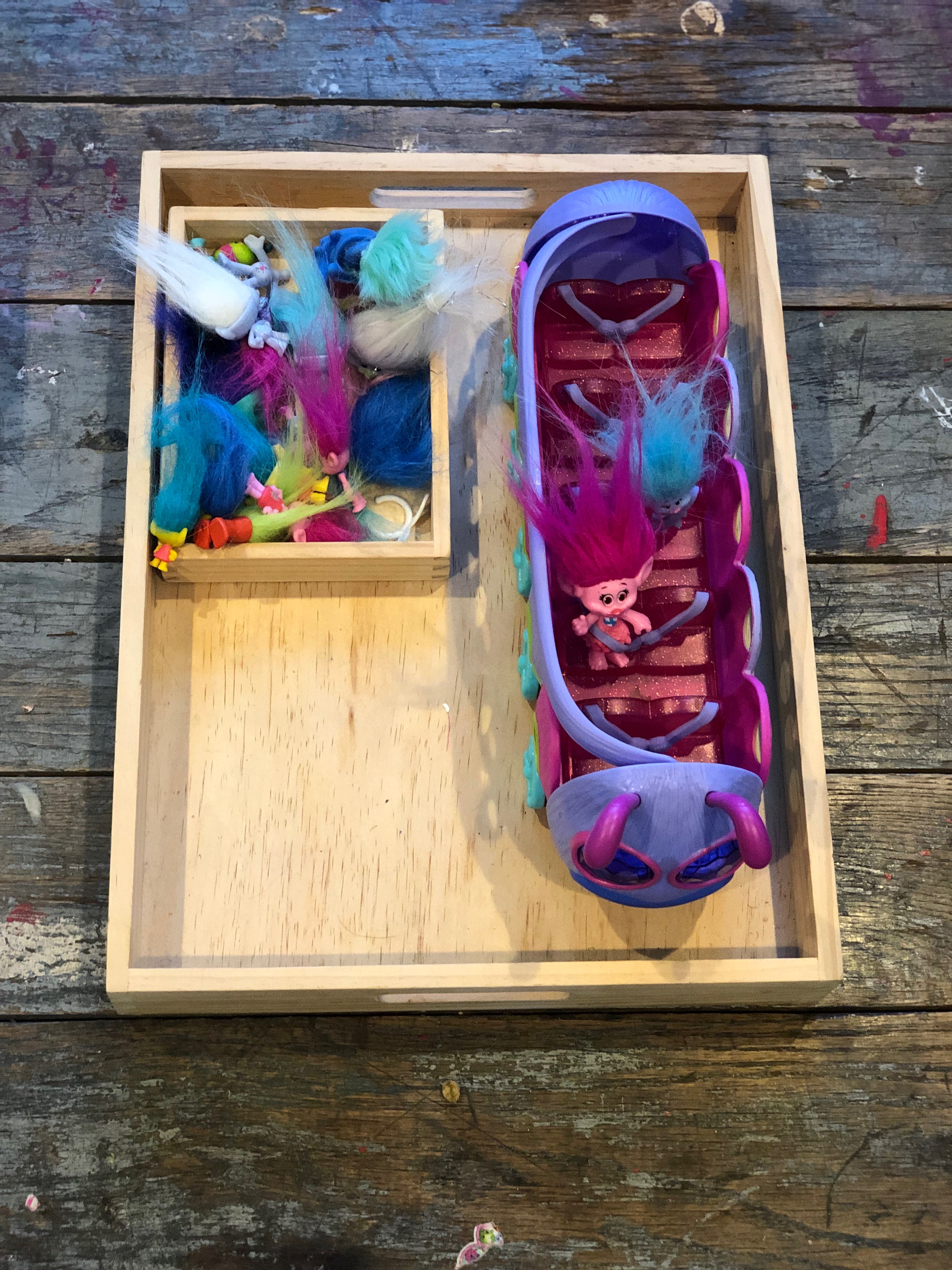
These Trolls have got a new lease on life just by grouping them on a tray so The Girl can put everyone on the Caturbus.
Other times, I give purpose to her regular toys by grouping them in thoughtful ways. Putting playsets together, collecting all the Peppa Pig characters in one place, putting the cars with the racetracks in a large bin, or just making sure the parts of the memory game are gathered and stored together-- these are all ways to make play more purposeful at your house.
Ideas for Works
To get your Montessori home set up going, open up the toy closet and look around for items that go together. While you’re sorting the toys into baskets, you will start to think about ways the toys can become works.
You can make a work out of anything!
Write some words on popsicle sticks and pop them in a metal lunch box with some of those fridge magnetic letters. Viola! A language work you can take in the car!
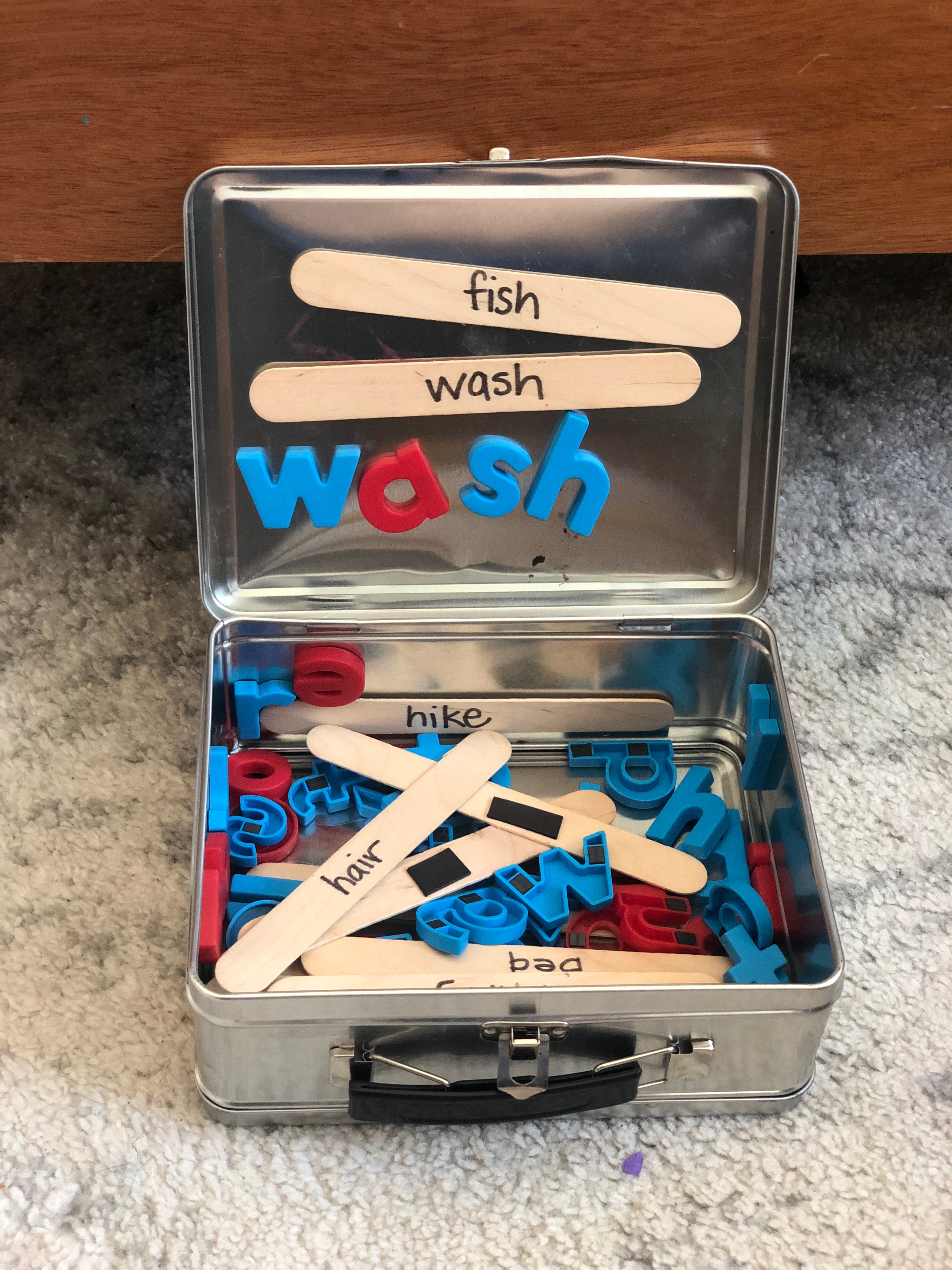
If you have a toddler, virtually ANYTHING can be a work, from pieces of string and a roll of masking tape, to toothpicks and an empty spice jar.
Just remember that you’re putting items together to deliberately build a skill or explore the world in a particular way.
My favorite resources for creating your own Montessori works:
Plenty of Trays: get ideas here for DIY works with stuff you have around the house
Racheous: DIY works to build fine motor skills
Living Montessori Now: Making your own works materials
Natural Beach Living: Around the house materials for traditional Montessori works
Get this two-page Montessori Set Up Guide to get started setting up your home with Montessori principles!
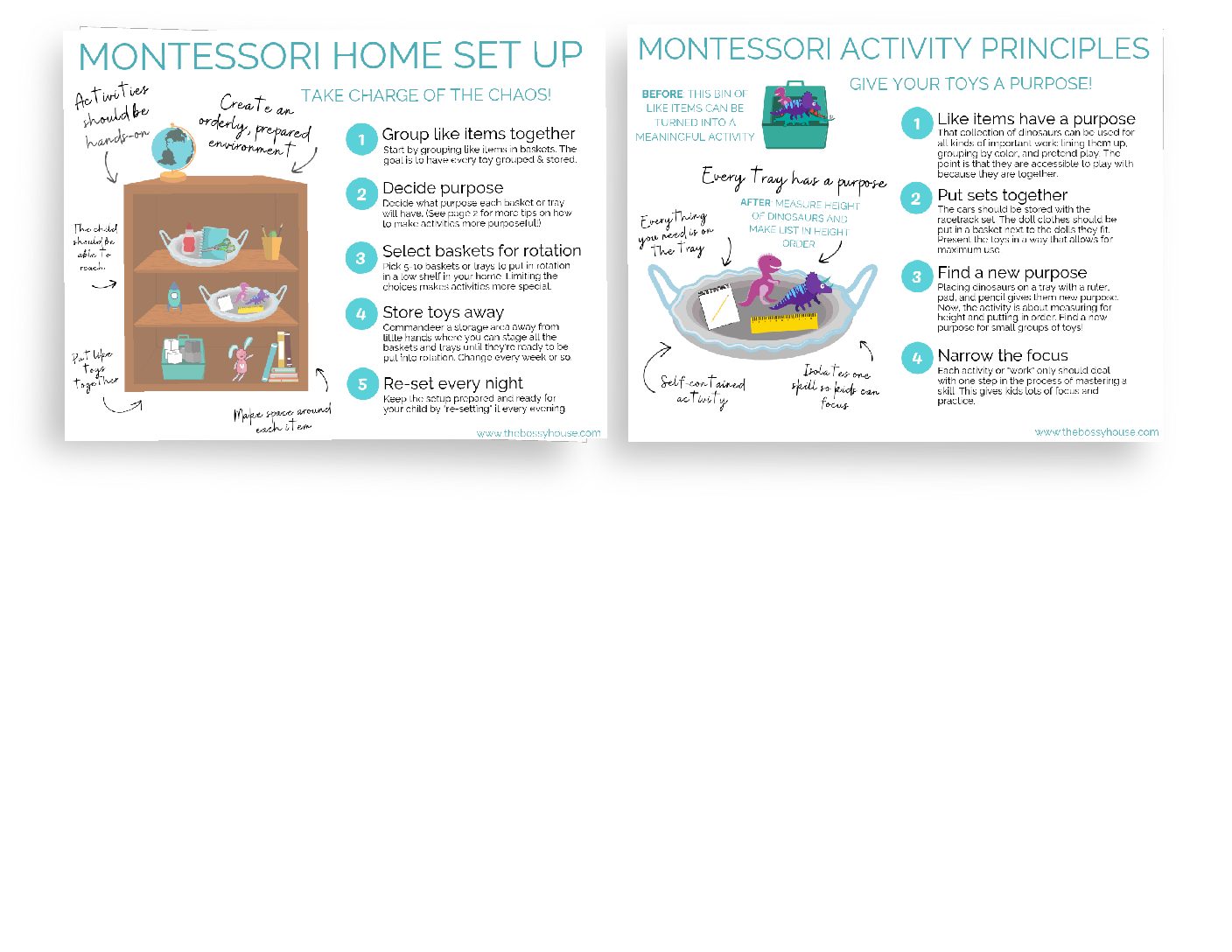


Awesome! Thanks, Anna!